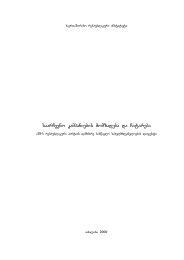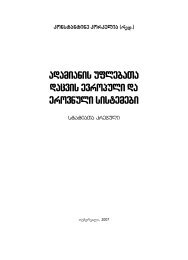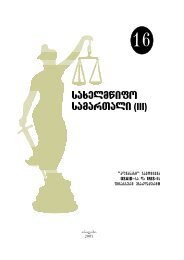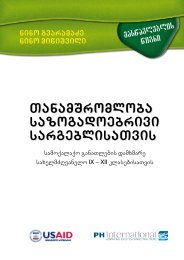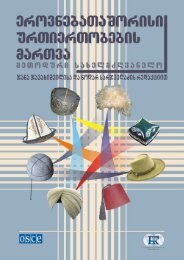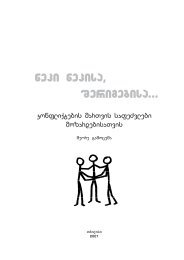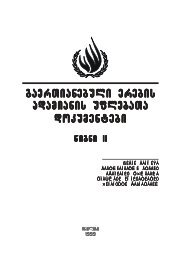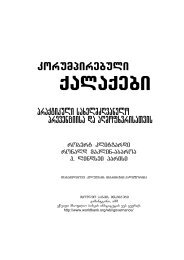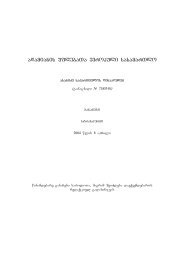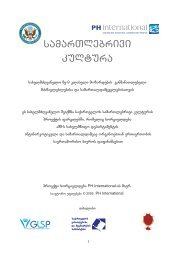The Geneva Protocol, by David Hunter Miller
The Geneva Protocol, by David Hunter Miller
The Geneva Protocol, by David Hunter Miller
Create successful ePaper yourself
Turn your PDF publications into a flip-book with our unique Google optimized e-Paper software.
CHAPTER III. 9<br />
CHAPTER III.<br />
THE COMING INTO FORCE OF THE PROTOCOL.<br />
<strong>The</strong> <strong>Protocol</strong> is dated at <strong>Geneva</strong> on October 2nd, 1924. It is drawn up in both French and English and the text<br />
of both languages is authentic. It is written in a single original. It was recommended to the Members of the<br />
League for acceptance <strong>by</strong> a resolution[1] unanimously passed in the Assembly <strong>by</strong> the affirmative vote of 48<br />
Members of the League, and it has been signed <strong>by</strong> the representatives of various countries.<br />
This recommendation <strong>by</strong> the Assembly, however, and these signatures, do not, as to any signatories, bring<br />
into force the <strong>Protocol</strong>, which, <strong>by</strong> its terms, must be ratified, the ratifications to be deposited at the Secretariat<br />
of the League at <strong>Geneva</strong>.<br />
<strong>The</strong> first preliminary to the coming into force of the <strong>Protocol</strong> is its formal ratification <strong>by</strong> at least 13 Members<br />
of the League; and these ratifications must include those of at least three of the four Great Powers which are<br />
Members--Great Britain, France, Italy and Japan. But even these ratifications do not bring the <strong>Protocol</strong> into<br />
force. <strong>The</strong> absence of such ratifications <strong>by</strong> May 1st, 1925, may result in the postponement of the Disarmament<br />
Conference from the date provisionally fixed, June 15th, 1925. But this is a matter which I shall discuss<br />
later.[2]<br />
If and when the ratifications above mentioned are deposited, a procès-verbal to that effect is drawn up; but<br />
this procès-verbal does not, as is usual when a procès-verbal of the deposit of ratifications is drafted, bring<br />
into force the <strong>Protocol</strong>. <strong>The</strong> date of the coming into force of the <strong>Protocol</strong> is stated as follows (Article 21):<br />
"as soon as the plan for the reduction of armaments has been adopted <strong>by</strong> the Conference provided for in<br />
Article 17."<br />
In other words, the <strong>Protocol</strong> will not bind any State that {6} ratifies it unless and until the Conference for the<br />
Reduction of Armaments adopts a Plan for such reduction. If such Conference is held and if such Plan is<br />
adopted, the <strong>Protocol</strong> will, on the date of the adoption of the Plan, come into force as among the States which<br />
have then ratified it. Such is the effect of the provisions of Article 21 of the <strong>Protocol</strong>.<br />
Other States, which have not at the date mentioned ratified the <strong>Protocol</strong>, may thereafter accede to it, as is<br />
provided <strong>by</strong> the third paragraph of Article 3, and of course the obligations of these States will commence with<br />
the date of such accession.<br />
Furthermore, provision is made[3] <strong>by</strong> which the <strong>Protocol</strong>, even after coming into force, may become, as it<br />
says, "null and void." It might well be argued that the becoming "null and void" of the <strong>Protocol</strong> related back to<br />
the date when it came into force.<br />
However this may be, it is important to notice here the provisions in this regard. <strong>The</strong> Conference for the<br />
Reduction of Armaments has, under the hypothesis, adopted a Plan for such reduction. That Conference has<br />
also to fix the time within which that Plan is to be carried out. <strong>The</strong> Council of the League is then to consider<br />
whether the Plan for the Reduction of Armaments adopted <strong>by</strong> the Conference has or has not been carried out<br />
within that fixed period. Presumably such consideration <strong>by</strong> the Council of the League would be had<br />
immediately after the expiration of the period fixed <strong>by</strong> the Conference; the Council, if it then considers that<br />
the Plan for the Reduction of Armaments has not been carried out, being limited, however, in such<br />
consideration to "the grounds" (French text--"conditions") laid down <strong>by</strong> the Conference in that respect, then<br />
declares that the Plan has not been carried out and the <strong>Protocol</strong> becomes "null and void."<br />
Accordingly, the <strong>Protocol</strong> can come into force as a legal obligation only on the date of the adoption <strong>by</strong> the<br />
Conference of the Plan for the Reduction of Armaments; and from that date till the date when the Council of




